Alaska Fish & Wildlife News
October 2023
Copper River Bison
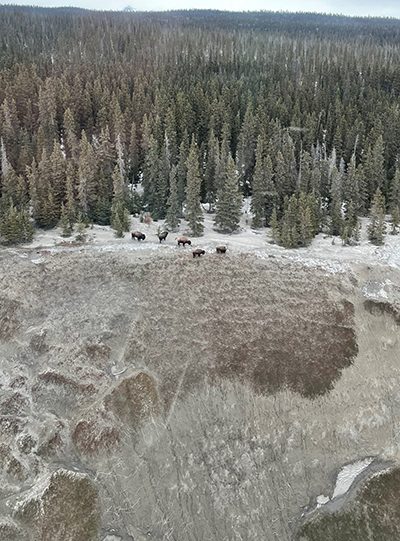
Bison trails crisscross the windswept bluff country along the Copper River. In early April this year, snow was still deep back in the trees, but the spring sun warmed the open ridges, and that’s where wildlife biologists Heidi Hatcher and Chris Brockman found the Copper River Bison Herd. Their aim was to capture and collar bison so they could be tracked for years to come. They’d flown out of Hatcher’s base in Glennallen, about 35 miles west, and that morning most of the herd was on those bluffs west of the Wrangell Mountains.
“When we first started the capture efforts our spotter plane had identified what we thought were about 50 bison on the bluffs and in the timber surrounding,” Hatcher said. “As we got in there and starting working, we realized how many more there were that you just couldn’t see in the air. We figured more like 90 by the time we were done, so getting out 10 collars representing 90 animals was a pretty good effort.”
Those collars are already providing valuable insights into this dynamic herd of landscape-changing animals.
“This is the first time in 30 years that we’ve had collars on that herd,” she said. “We’re deploying GPS satellite collars, so we’re getting regular location updates and hope to document the seasonal movements and range use of the herd as has never been done before.”
Bison backstory
Plains bison are not native to Alaska, and Alaska’s animals are from a rare stock of genetically pure plains bison. Bison were brought to Alaska from the National Bison Range in Montana in 1928, before that herd interbred with domestic cattle. About 20 bison were initially introduced near Delta Junction and formed the Delta herd. In the 1950s and ‘60s, bison from the growing Delta herd were transplanted to other areas to start three additional Alaska herds. The Copper River Herd was the first. In 1950, 17 bison from Delta were trucked a couple hundred miles south and released in the upper Copper River Valley northeast of the Sanford River (near Slana) but they soon left for greener pastures about 75 miles further south.
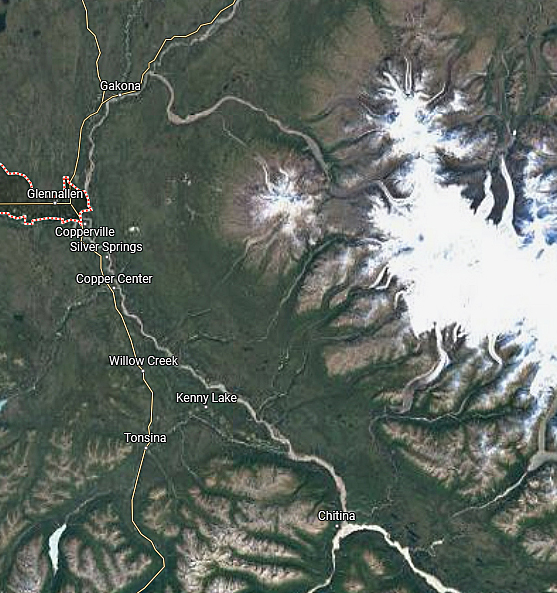
"They moved themselves down the Copper River all the way to where they are now, and they decided to settle on this area,” Hatcher said. They range from broad timbered plains along the east side of the Copper River to the more open river country of the upper Dadina and Chetaslina rivers on the western slope of the Wrangell Mountains. Most of the area is in the Wrangell-St. Elias National Preserve. The National Park Service and Ahtna, Inc.provided permits to capture bison on the lands, which is greatly appreciated.
They move seasonally - often to predictable locations, but the timing varies, influenced by weather, snow depth, snow melt and green up.
“We don’t know why they choose to move to the upper Dadina early versus late,” she said. “One year we found a bunch there in late July, and that year we had the highest count ever. These collars will give us an idea when to start looking.”
Captures and Collaring
When bison are captured, animal care is the priority. They are darted from a helicopter. Sometimes an animal may run before the drugs take effect, other times they just walk a few steps and calmly lay down. When it’s safe to approach the drugged animal, biologists go to work. First, the animal’s temperature is taken while the collar is being affixed and if the animal is too hot, the drugs are immediately reversed. Generally, all is well and in addition to the collaring, samples and measurements are taken.
Wool and hair samples provide DNA and can be analyzed for chemicals and hormones, just as human hair can be tested for drugs and exposure to toxic elements. Bison hair can be analyzed for cortisol, a hormone that spikes when an animal is stressed. Bison retain their tail hair for life, and a wildlife physiologist can examine that lifetime record in year-by-year segments and look for cortisol spikes that could indicate stressful periods, such as harsh winters.
Nasal swabs are sent to the wildlife health veterinarians to screen for respiratory pathogens such as M.Ovi and Covid. Hatcher and Brockman take pictures of the animals from the front and side, and measure the distance between the horns, and between the base of the horns and the tail. “With photocensus technology, we might get to a point where we could sex and age bison from photos based on body measurements,” Hatcher said.
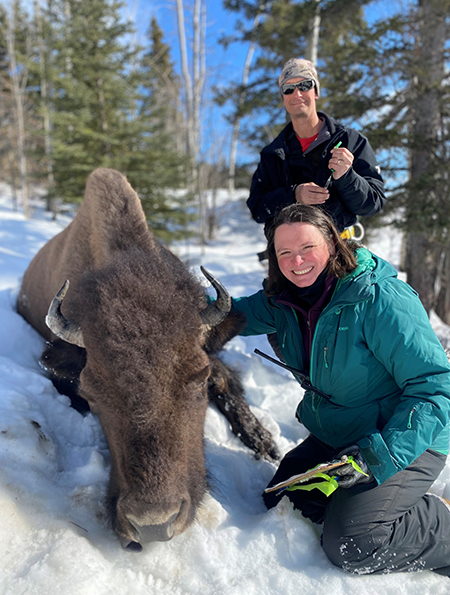
They examine growth rings on the horns and wear on the teeth to help estimate the animal’s age. To fine-tune their ability to estimate a bison’s age, they also take pictures, and will compare the appearance to the actual age when they learn it.
“We captured one cow we estimated to be 16 years - we don’t expect them to get older than that in the wild,” she said. “We’d expect a bull’s lifespan to be less. They live longer in captivity, but they have a much easier life in captivity.”
The Bison Survey
Hatcher said the main impetus for the collars is to let biologists know when the majority of the animals make it to the upper Dadina in late spring or early summer. That’s where they conduct the annual survey of the herd, flying over and counting and photographing bison. They get an actual count of the animals that survived the winter, a look at calves born that spring, and an estimate of the total number in the herd - knowing that some bison might not be seen. Along the Dadina River, bison are more likely to be in the open, ideally in groups on gravel bars. It’s a busy time of year for wildlife biologists - Hatcher also has moose and caribou to survey – so knowing when to schedule aircraft and budget the time is important.
Hatcher said the timing of the herd’s arrival to the upper Dadina varies drastically from year to year. “So traditionally we’ve sent a plane up there now and then to take a look, in hopes of finding them in a good area to survey, and that approach sometimes misses the mark. Hopefully we’ll be able to better time our efforts now that we have real-time indicators of their location and movements.”
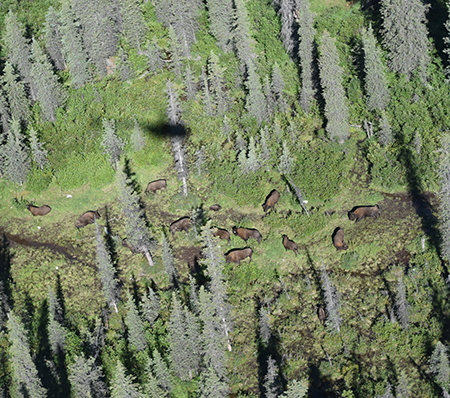
The management objective is to maintain the herd at a minimum of 60 overwintering adults. Herd estimates have varied from a low of 51 bison in 1967 to a high of 225 bison in 2017. When numbers are too low, hunting season is closed. In 1989 a cold winter with an extremely deep snowpack took a toll on the bison, and hunting was closed for a decade, until herd size and productivity brought numbers back up.
Hunters apply for a limited number of tags, awarded in a lottery-style drawing, and higher bison numbers indicates the herd can sustain a larger harvestable surplus. About two dozen permits are issued each year, with an annual harvest around 10. Hunting season runs fall through spring, but because mid-winter is cold, dark and unpredictable, hunters tend to favor fall (when they can boat in) and late winter (when they can snowmachine or fly into the area).
The minimum count this year is 98, with an estimate that there may be as many as 137 bison. Hatcher said she thought last fall there could be between 150 and 200 bison going into the winter – but now she knows that 27 bison did not survive. Hunters harvested 12 bison during the hunting season, and during the April bison captures biologists found a cow and a calf that had been killed by wolves - and they saw a wolf pack nearby. And there was the ‘mortality event.’
“It was first reported by a member of public, in the spring on the Copper River, right after break up in May,” she said. “We got a report about ‘dead bison island.’ We flew out and documented 12 dead bison of all different sexes and age classes, melting out of the ice. I suspect an early winter overflow event killed them. This group had somehow gotten stranded on this island and were caught in the overflow.”
“After that, a spotter plane spotted a dead bull five miles downriver from the island. We ran over there and checked out the bull that also apparently drowned. It may or may not have been from the same event. He had washed up on a gravel bar and the critters were just getting on him.”
Mortality and other signals
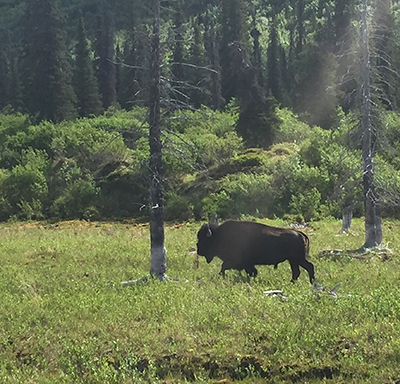
No collared animals have died yet, but if a collared animal dies, a signal lets the biologist know. Typically, the mortality signal is triggered when the animal is motionless for a period of time – for Hatcher’s bison, that’s 12 hours. (This can be important, for example, when predation is a key part of research, a biologist will want to get onsite as soon as possible to examine the remains and determine what kind of predator was involved.)
Hatcher has set up the collars to log a location point every 12 hours, and she receives an update on their movements every few days. “That’s how I have it set up now,” she said, “I could tell the collars to collect the data more frequently, but I don’t need that. All the data is sent to me through satellite communication.”
That’s a big improvement over the old collars which stored data. The collar (and the valuable data) was retrieved using an onboard VHF radio transmitter, which sends a signal a biologist uses to home in on the collar. That’s still a feature biologists use when they want to locate the animals in real time – or retrieve a collar from a dead animal.
Hatcher uses collars that only have VHF transmitters for other research. They’re less expensive and they last a long time.
“I still put out a lot of VHF collars on caribou and moose,” she said. “I have some that are 20 years on the air, and some that will last for 12 years, which often covers the lifespan of our caribou. There are certain things we only need to do once or twice a year: get eyes on the animal, find the herd, and get parturition data (whether or not a cow had a calf, and with moose whether or not she had twins). With bison, we need the movement data and the GPS is helpful – you know where they are throughout the year. For moose, we almost exclusively use VHF because we don’t need all that GPS data.”
The ability to reprogram the collar remotely and change the frequency of location fixes is a major improvement. That’s something a biologist might want to do seasonally, for example, a bear researcher would reduce the recording of location points dramatically once a bear has settled in a den to hibernate.
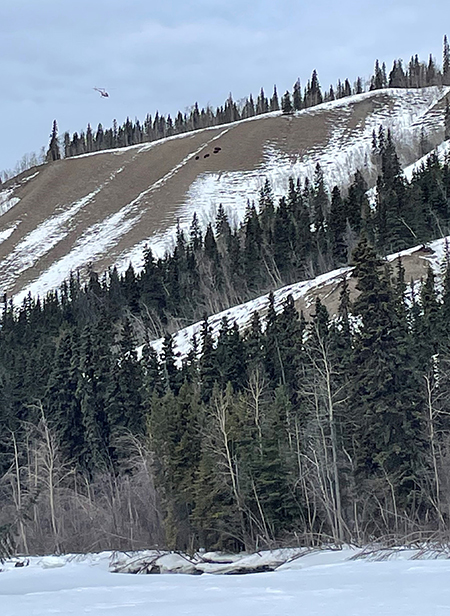
The battery packs can now be swapped out, rather than sending in the entire device for refurbishing. The battery life is phenomenal in new bison GPS collars. “I should get at least five years, and I’m hoping for longer,” she said.
Habitat engineers
That network of trails crisscrossing the Copper River bluffs represents more than bison travels. Bison alter the landscape in their favor.
“Bison are essentially thought of as creatures that create their own habitat,” Hatcher said. “Their behavior changes the vegetation structure and what grows there. Once they start trampling it a lot, rolling around in it, doing what they do as bison, it can shift from tundra-mossy to more of a sedge-type environment, with more of the foods growing that they’re interested in. It’s really striking when you’re walking in the forest where bison spend a lot of time, it seems very different than walking in parts of that same forest where the bison aren’t. The forest is more open, there are more grasses, and lots of willows, it’s like walking through a different habitat - a habit that’s way more suited to bison.”
Next spring Hatcher plans to add 15 more collars to the Copper River Herd. She’s also considering more targeted research down the road, sampling vegetation and as they document current range use, compare that to other areas that are not being used.
“Having these collars and knowing their range gives us more insights,” she said. “We’re getting a better understand of the herd than we’ve ever had before.”
More on Bison
Subscribe to be notified about new issues
Receive a monthly notice about new issues and articles.
